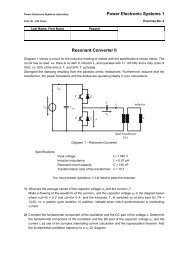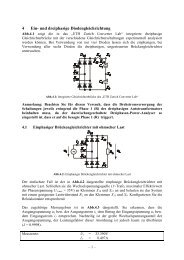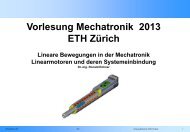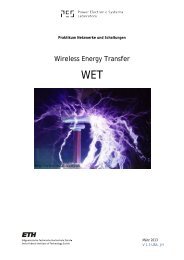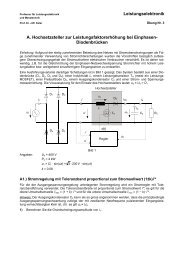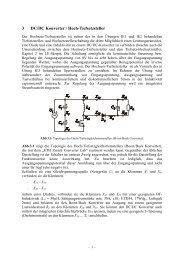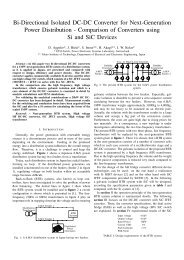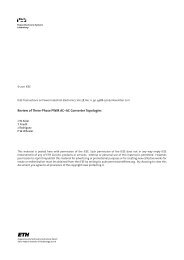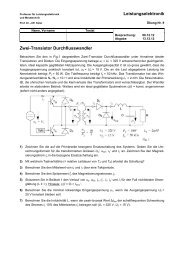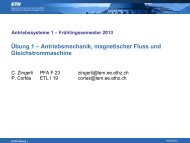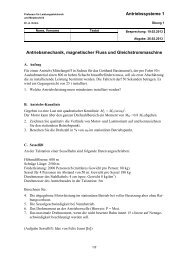U. Badstübner, J. Biela, J. W. Kolar, Power Density and Efficiency ...
U. Badstübner, J. Biela, J. W. Kolar, Power Density and Efficiency ...
U. Badstübner, J. Biela, J. W. Kolar, Power Density and Efficiency ...
You also want an ePaper? Increase the reach of your titles
YUMPU automatically turns print PDFs into web optimized ePapers that Google loves.
1 2 3 4<br />
Table II: Constraints used for the optimization procedure<br />
(CSPI = Cooling System Performance Index cf. [17]).<br />
s 11<br />
s 21<br />
s 12<br />
s 22<br />
V IN<br />
s11 s12 I P<br />
A B<br />
s21<br />
s 22<br />
Leg A Leg B<br />
s11<br />
s21<br />
s12<br />
s22<br />
I P<br />
s11<br />
s21<br />
s12<br />
s22<br />
I P<br />
s11<br />
s21<br />
s 12<br />
s 22<br />
I P<br />
t<br />
t<br />
t<br />
Max. Width<br />
1 U = 1.75 in ≈ 44 mm<br />
Core Material N87 (EPCOS, T max ≤ 115 ◦ C)<br />
MOSFETs<br />
APT50M75 (Mircosemi, former APT)<br />
Rectifier Diodes APT100S20 (Mircosemi, former APT)<br />
Capacitors C S <strong>and</strong> C P 3.9 nF, 800 V, COG (NOVACAP)<br />
CSPI 23<br />
Max. Junction Temp. T j,max ≤ 140 ◦ C<br />
V AB<br />
SPR<br />
+V IN CTC<br />
CDR<br />
Figure 3: Switching states <strong>and</strong> current waveforms for phaseshift<br />
converter with capacitive output filter <strong>and</strong> current doubler<br />
as well as for the series-parallel resonant DC-DC converter<br />
with capacitive output filter.<br />
while most of the disadvantages of the two converters are<br />
eliminated (e.g. [6], [9], [14]. Furthermore, the converter<br />
is naturally short circuit proof.<br />
For a compact design, a center-tapped transformer with<br />
rectifier as output stage results in a lower volume if high output<br />
currents are required. As presented in [8], the capacitive output<br />
filter (cf. Fig. 1 b) results in a smaller volume than the LCfilter<br />
for high output currents. Therefore, the LC-filter is not<br />
considered in the following.<br />
As the phase-shifted converter, the series-parallel resonant<br />
converter provides soft switching of all 4 switches. By<br />
controlling the zero-crossing of the resonant current I P it is<br />
possible to achieve zero-voltage switching in one leg <strong>and</strong> zerocurrent<br />
switching (ZCS) in the other one.<br />
The operation principle of the switches is similar to the<br />
phase-shifted converter as shown in Fig. 3. Due to the<br />
filtering action of the resonant circuit the primary current I P<br />
is approximately sinusoidal, which has the benefit of better<br />
EMI performance.<br />
As it can be seen in the schematics (Fig. 1b) <strong>and</strong> Fig.<br />
2) <strong>and</strong> the control scheme (cf. Fig. 3), the phase-shift <strong>and</strong><br />
the resonant converter are very similar <strong>and</strong> show almost the<br />
same performance <strong>and</strong> similar efficiency (e.g. [3]). Thus,<br />
conventional criteria are not sufficient to identify the most<br />
suitable especially in respect to minimal volume, lowest cost<br />
or highest efficiency. By means of optimizing the three<br />
converter topologies for one or even more criteria like power<br />
density <strong>and</strong>/or efficiency based on detailed models, a profound<br />
comparison based on the optimization is possible. This<br />
optimization procedure <strong>and</strong> the associated models described<br />
in the following section.<br />
-V IN<br />
III. OPTIMIZATION PROCEDURE<br />
For the comparison of the different topologies, the component<br />
values must be chosen, so that the power density<br />
<strong>and</strong>/or the efficiency becomes maximal. Since the volume<br />
of the single components, which are mainly limited by the<br />
respective maximum operation temperature, interdependent to<br />
some extent on each other, the optimization of the overall<br />
volume is a quite difficult task with many degrees of freedom.<br />
Therefore, an automatic optimization procedure is applied for<br />
determining the optimal component values of the telecom<br />
supply.<br />
The optimization procedure is mainly based on 4 models:<br />
• An analytical converter model, based on the extended<br />
fundamental analysis (series-parallel resonant converter,<br />
[8], [15]) <strong>and</strong>/or time domain analysis (phase-shift converter,<br />
[16]), respectively<br />
• Equations for the semiconductor switching <strong>and</strong> conduction<br />
losses, based on measurements<br />
• Model for the volumes of the resonant tank capacitors,<br />
including dielectric losses<br />
• A model of the losses <strong>and</strong> the temperature distribution<br />
in the transformer with integrated series inductance for<br />
optimizing the transformer geometry.<br />
In the following the optimization procedure will be explained<br />
briefly. There, also references where the models are explained<br />
in detail are listed.<br />
The starting point of the procedure is the initialization<br />
of the design parameters like input voltage, output power,<br />
temperature limits <strong>and</strong> material characteristics as presented<br />
partially in table I <strong>and</strong> table II. These parameters as well<br />
as starting values like C S , C P , L S , L Out1,2 <strong>and</strong> the number<br />
of turns of the transformer (N P <strong>and</strong> N S ) must be specified by<br />
the user.<br />
With the values for the magnetic components <strong>and</strong> the turns<br />
number the model for the magnetic components is parameterized.<br />
There, a reluctance model of the transformer with integrated<br />
inductance in combination with the analytical converter<br />
model, which describes the operation of the converter <strong>and</strong> the<br />
flux distribution in the core is used in case of the resonant<br />
converter [8], [15]. The models for the phase-shift converters<br />
are based on analytical expression for the flux distribution <strong>and</strong><br />
the optimal winding geometry [18].<br />
With the frequency, duty cycle, currents <strong>and</strong> voltages resulting<br />
from the analytical converter model [8], [15], the value <strong>and</strong><br />
volumes of resonant tank capacitors as well as the switching<br />
<strong>and</strong> conduction losses in the MOSFETs <strong>and</strong> rectifier diodes<br />
are determined, based on the models presented in [8]. These<br />
losses, the ambient temperature <strong>and</strong> the maximum junction<br />
temperatures of the semiconductor devices are used for calcu-



